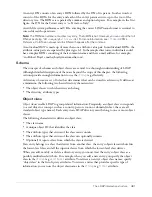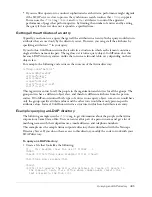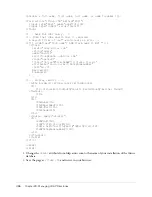
492
Chapter 23: Managing LDAP Directories
<cfif Trim(Form.fullName) is ""
OR Trim(Form.surname) is ""
OR Trim(Form.email) is ""
OR Trim(Form.phone) is "">
<h2>You must enter a value in every
field.</h2>
<cfset fullNameValue=
Form.fullName>
<cfset surnameValue=
Form.surname>
<cfset emailValue=Form.email>
<cfset phoneValue=Form.phone>
<cfset uidValue=Form.uid>
If any field in the submitted form is blank, display a
message and set the other form fields to display
data that the user submitted.
<cfelse>
<cfset attributelist=
"objectclass=top,person,
organizationalperson,
inetOrgPerson;
cn=#Trim(Form.fullName)#;
sn=#Trim(Form.surname)#;
mail=#Trim(Form.email)#;
telephonenumber=
#Trim(Form.phone)#;
ou=Human Resources;
uid=#Trim(Form.uid)#">
If the user entered data in all fields, sets the
attributelist variable to specify the entry’s attributes,
including the object class and the organizational
unit (in this case, Human Resources).
The
Trim
function removes leading or trailing
spaces from the user data.
<cfldap action="add"
attributes="#attributeList#"
dn="uid=#Trim(Form.uid)#,
ou=People, o=Airius.com"
server=#myServer#
username=#myUserName#
password=#myPassword#>
<cfoutput><h3>Entry for User ID
#Form.uid# has been added</h3>
</cfoutput>
</cfif>
</cfif>
</cfif>
Adds the new entry to the directory.
<cfform action="update_ldap.cfm"
method="post">
<table>
<tr><td>Full Name:</td>
<td><cfinput type="Text"
name="fullName"
value=#fullNameValue#
size="20"
maxlength="30"
tabindex="1"></td>
</tr>
.
.
.
<tr><td colspan="2">
<input type="Submit"
name="action"
value="Add"
tabindex="6"></td>
</tr>
</table>
<br>
*All fields are required for Add<br>
</cfform>
Outputs the data entry form, formatted as a table.
Each
cfinput
field always has a value, set by the
value
attribute when the page is called. The
value
attribute lets ColdFusion update the form contents
when the form is redisplayed after the user clicks
Add. The code that handles cases in which the user
fails to enter all the required data uses this feature.
Code
Description
Summary of Contents for ColdFusion MX
Page 1: ...Developing ColdFusion MX Applications...
Page 22: ...22 Contents...
Page 38: ......
Page 52: ...52 Chapter 2 Elements of CFML...
Page 162: ......
Page 218: ...218 Chapter 10 Writing and Calling User Defined Functions...
Page 250: ...250 Chapter 11 Building and Using ColdFusion Components...
Page 264: ...264 Chapter 12 Building Custom CFXAPI Tags...
Page 266: ......
Page 314: ...314 Chapter 14 Handling Errors...
Page 344: ...344 Chapter 15 Using Persistent Data and Locking...
Page 349: ...About user security 349...
Page 357: ...Security scenarios 357...
Page 370: ...370 Chapter 16 Securing Applications...
Page 388: ...388 Chapter 17 Developing Globalized Applications...
Page 408: ...408 Chapter 18 Debugging and Troubleshooting Applications...
Page 410: ......
Page 426: ...426 Chapter 19 Introduction to Databases and SQL...
Page 476: ...476 Chapter 22 Using Query of Queries...
Page 534: ...534 Chapter 24 Building a Search Interface...
Page 556: ...556 Chapter 25 Using Verity Search Expressions...
Page 558: ......
Page 582: ...582 Chapter 26 Retrieving and Formatting Data...
Page 668: ......
Page 734: ...734 Chapter 32 Using Web Services...
Page 760: ...760 Chapter 33 Integrating J2EE and Java Elements in CFML Applications...
Page 786: ...786 Chapter 34 Integrating COM and CORBA Objects in CFML Applications...
Page 788: ......
















































